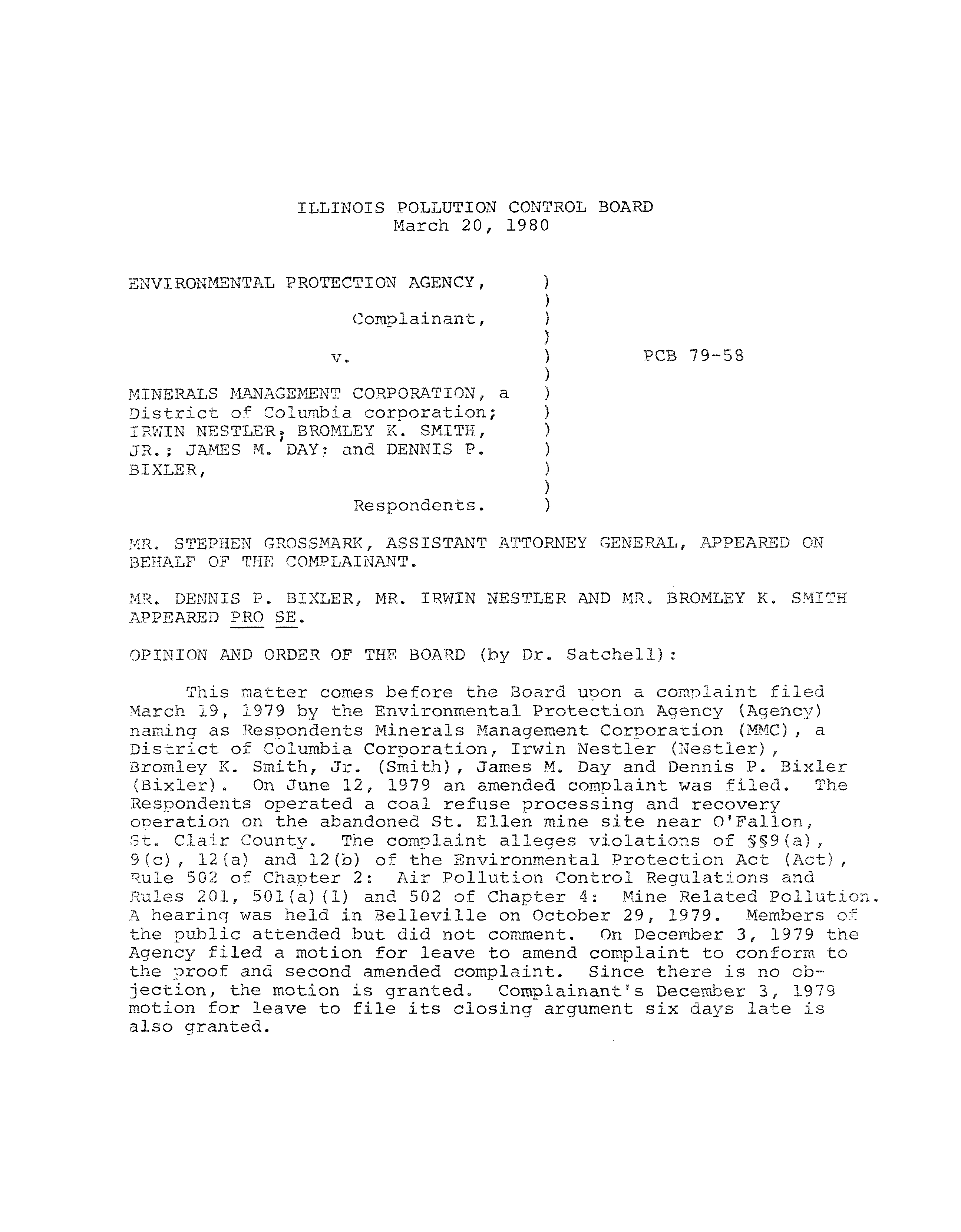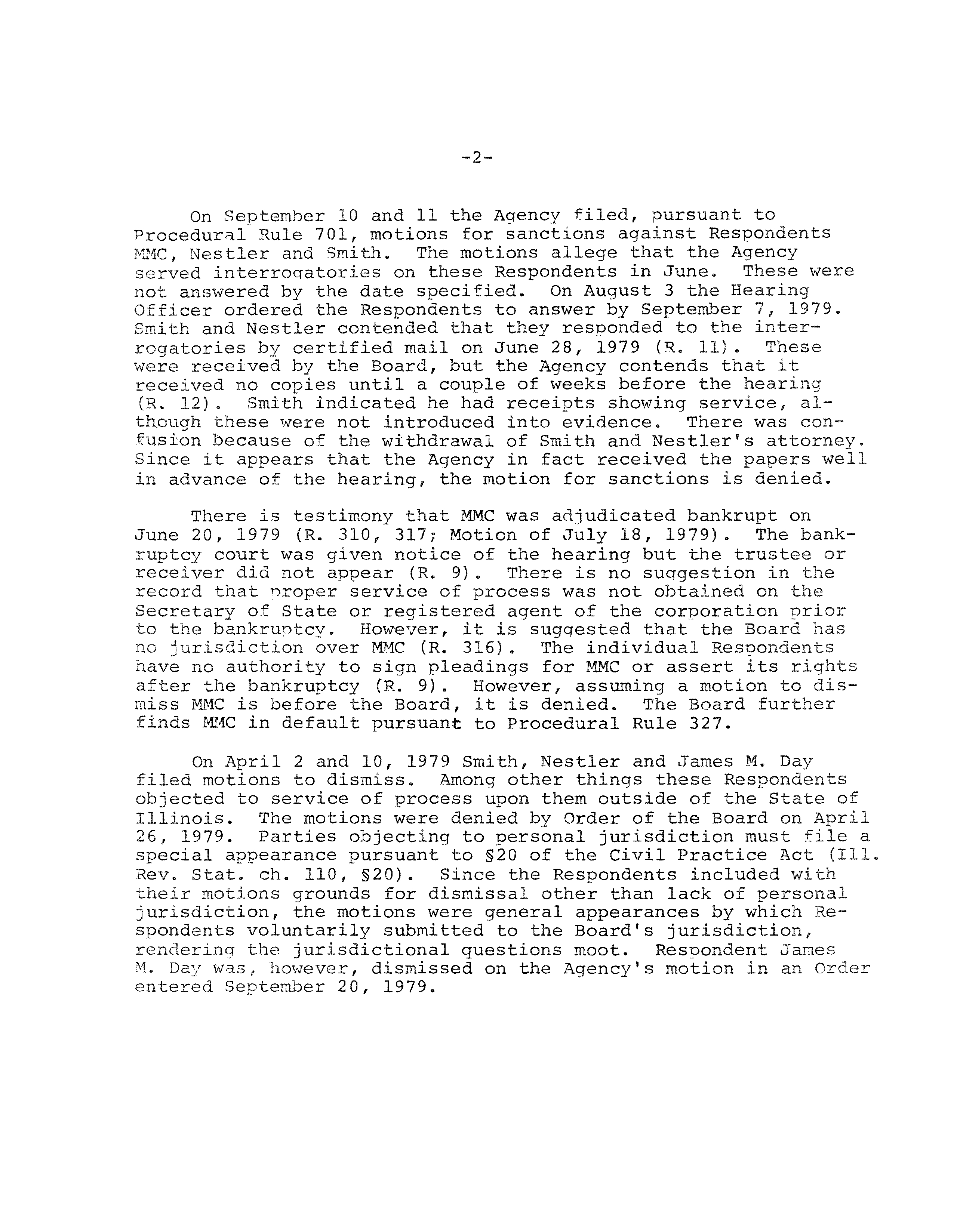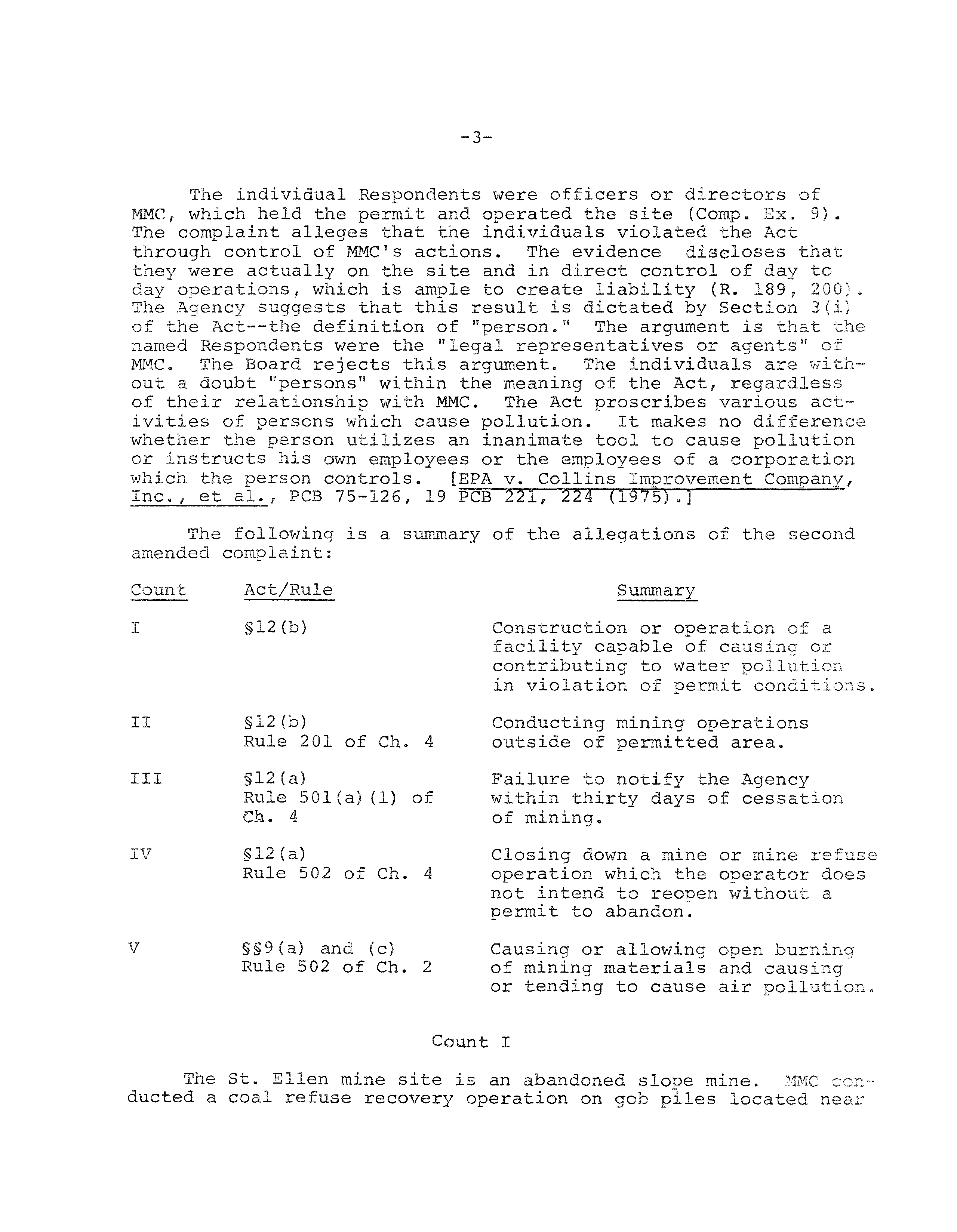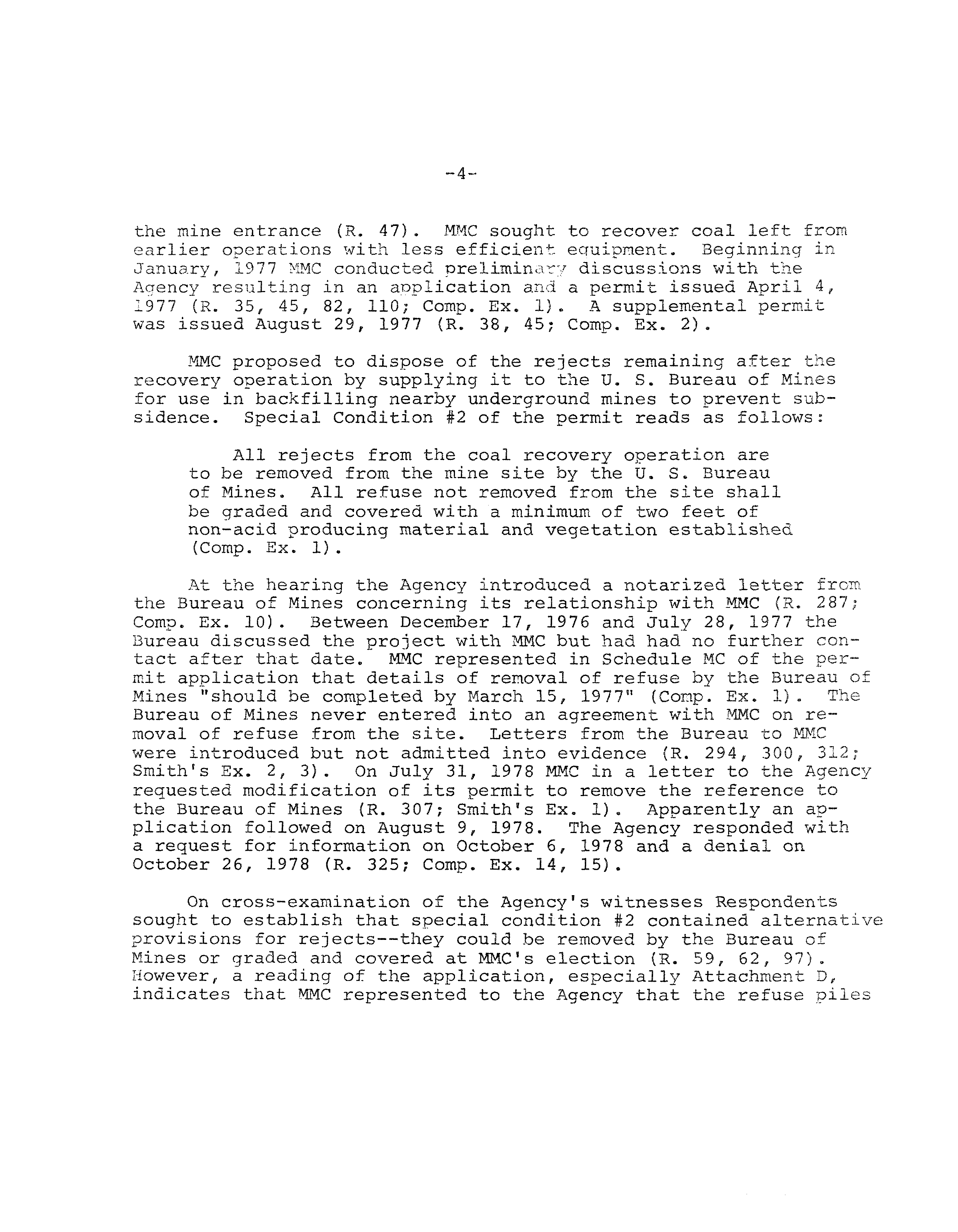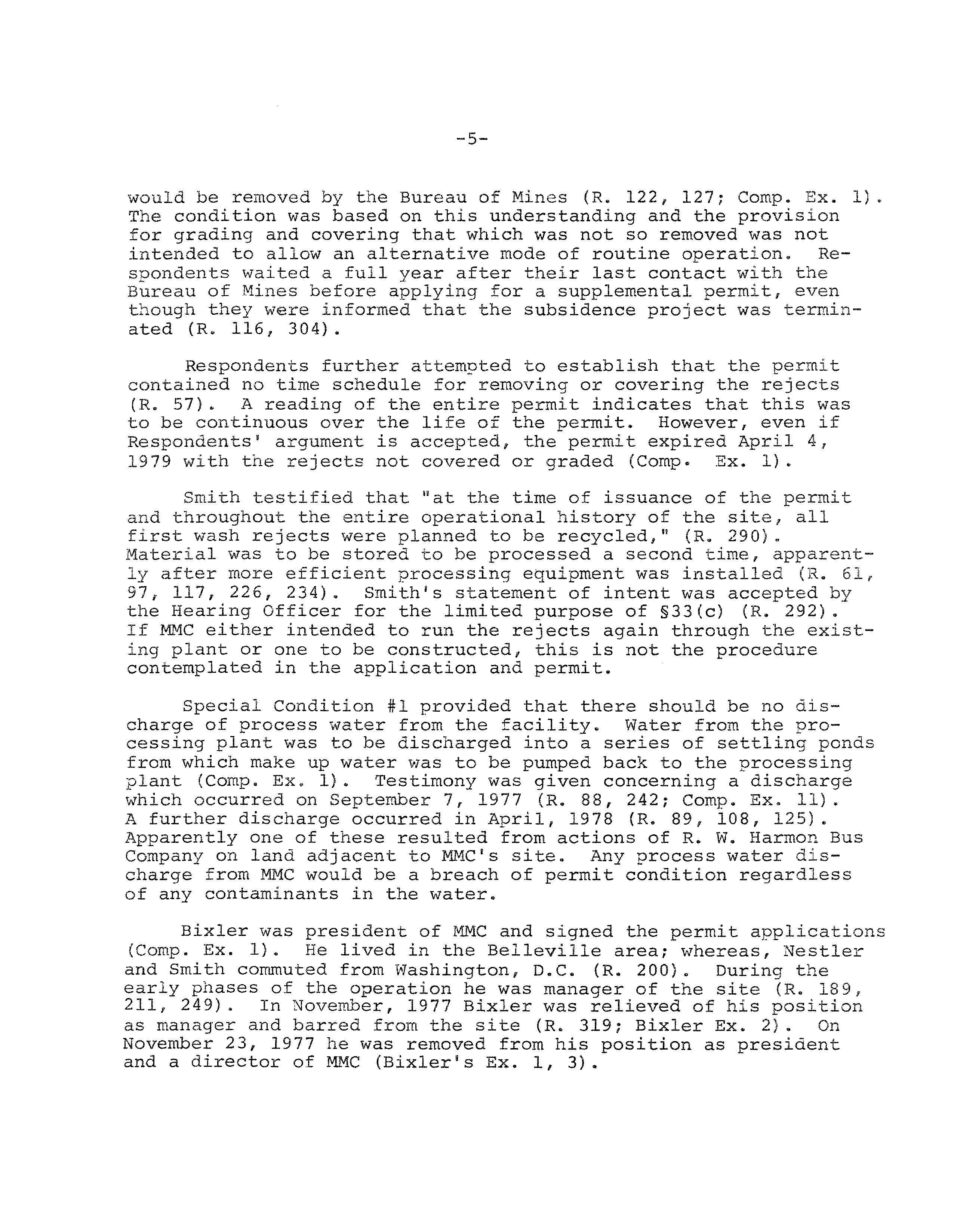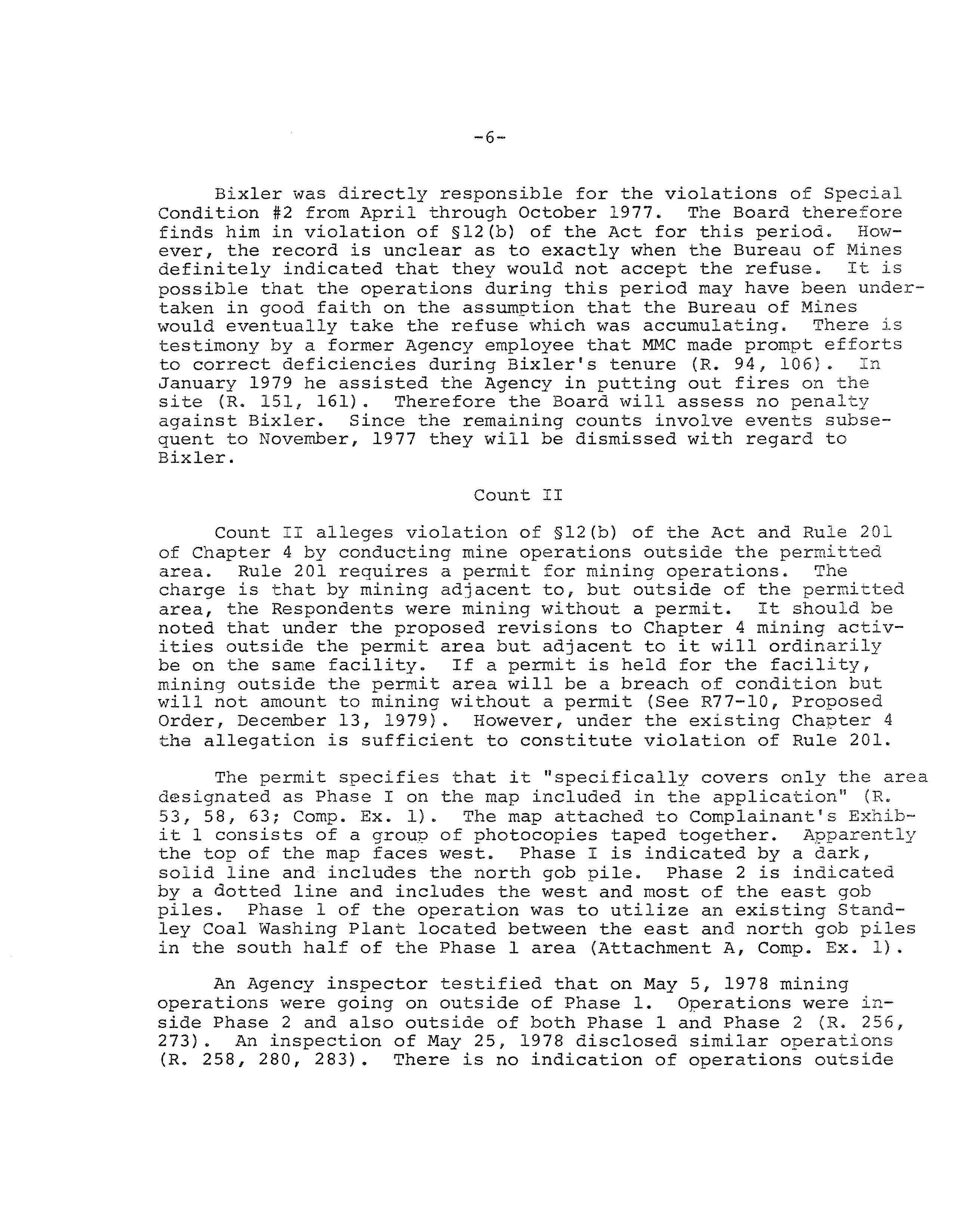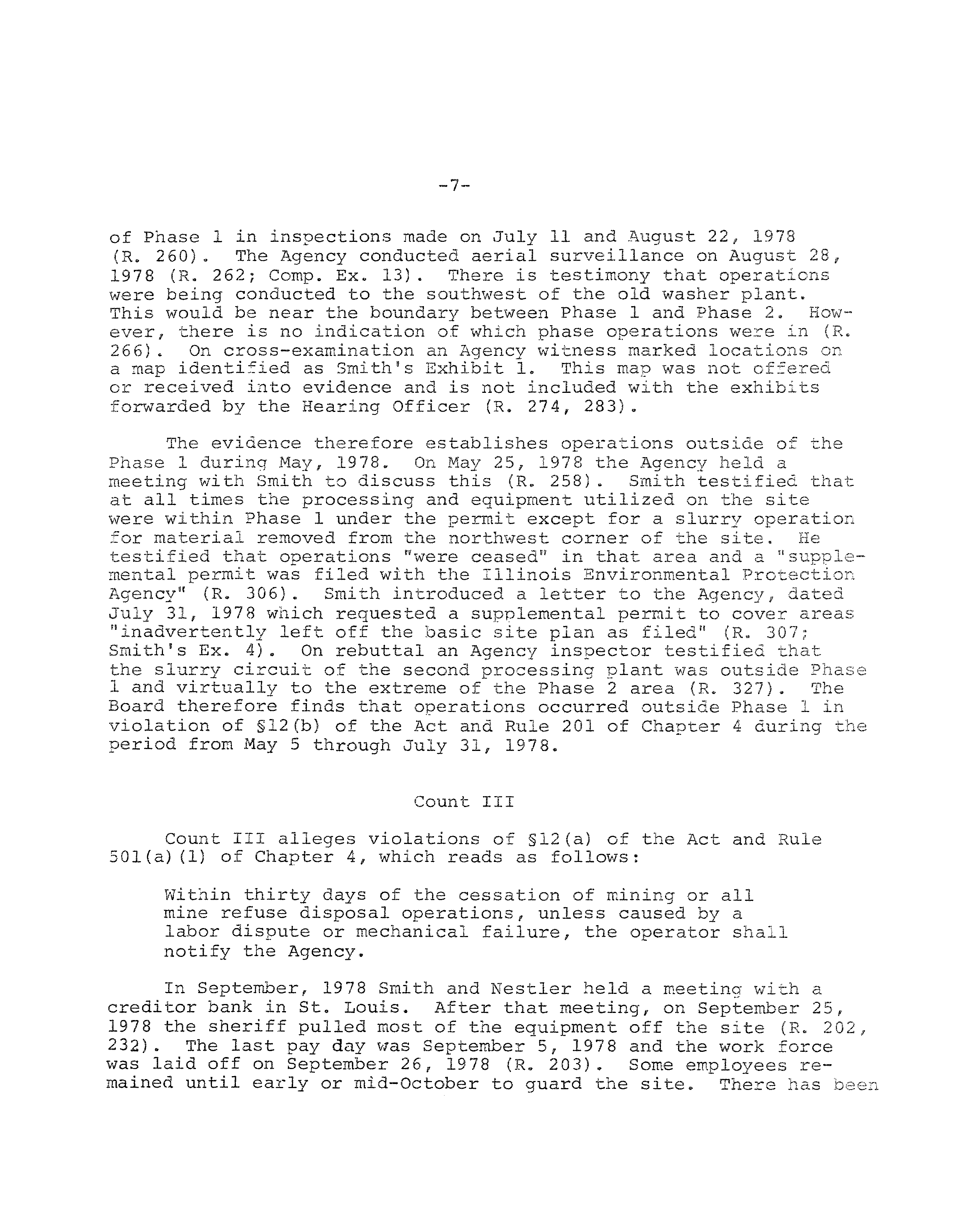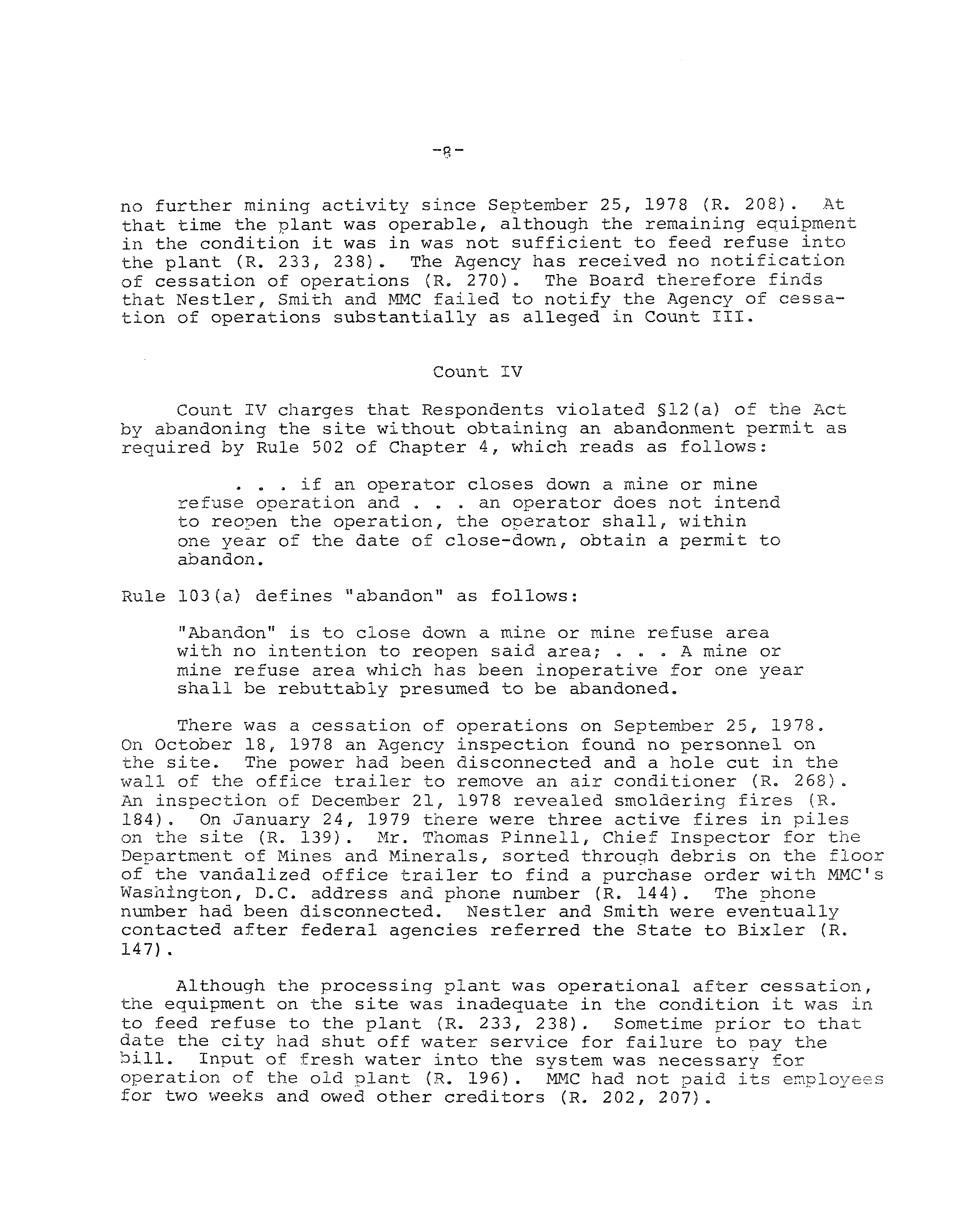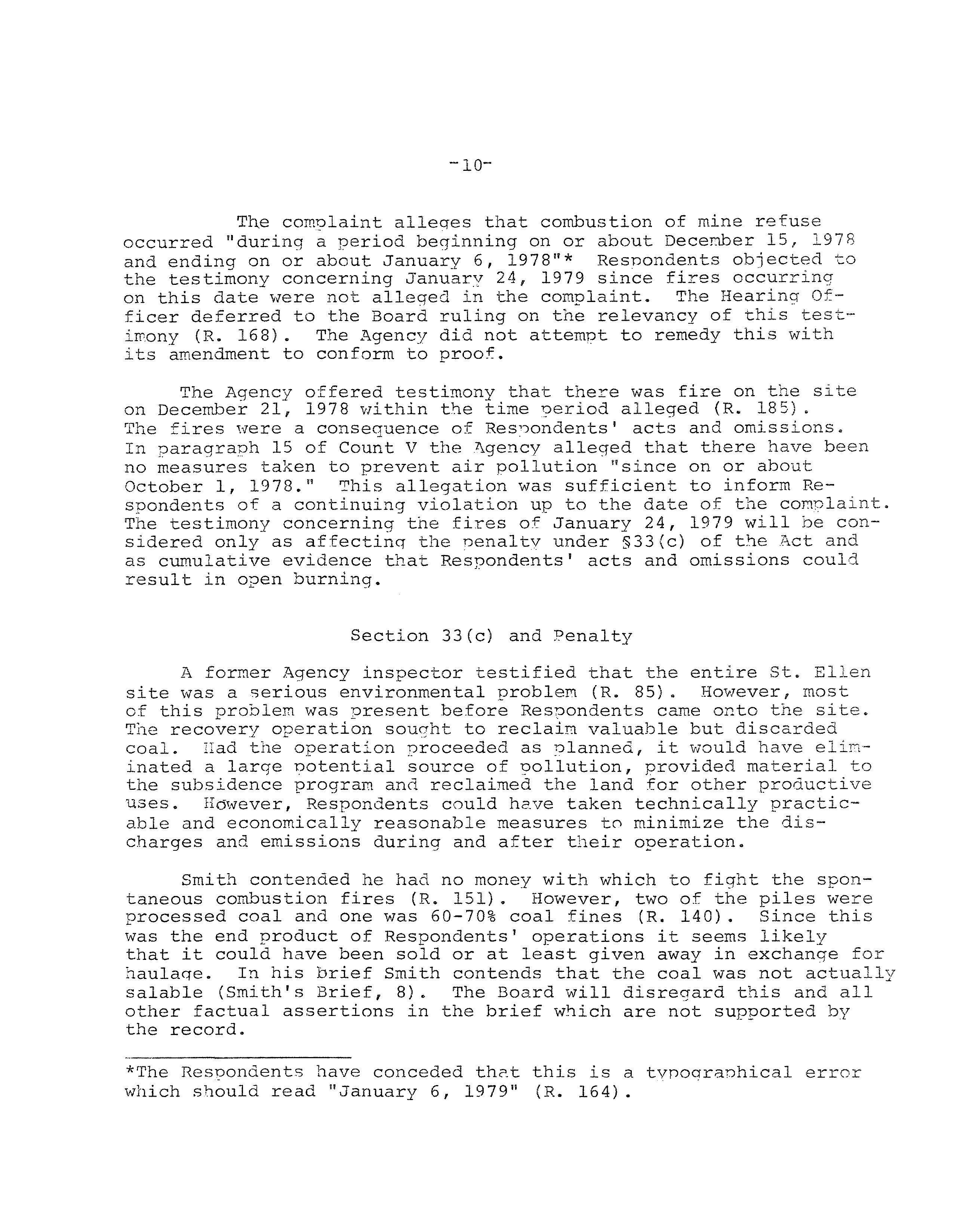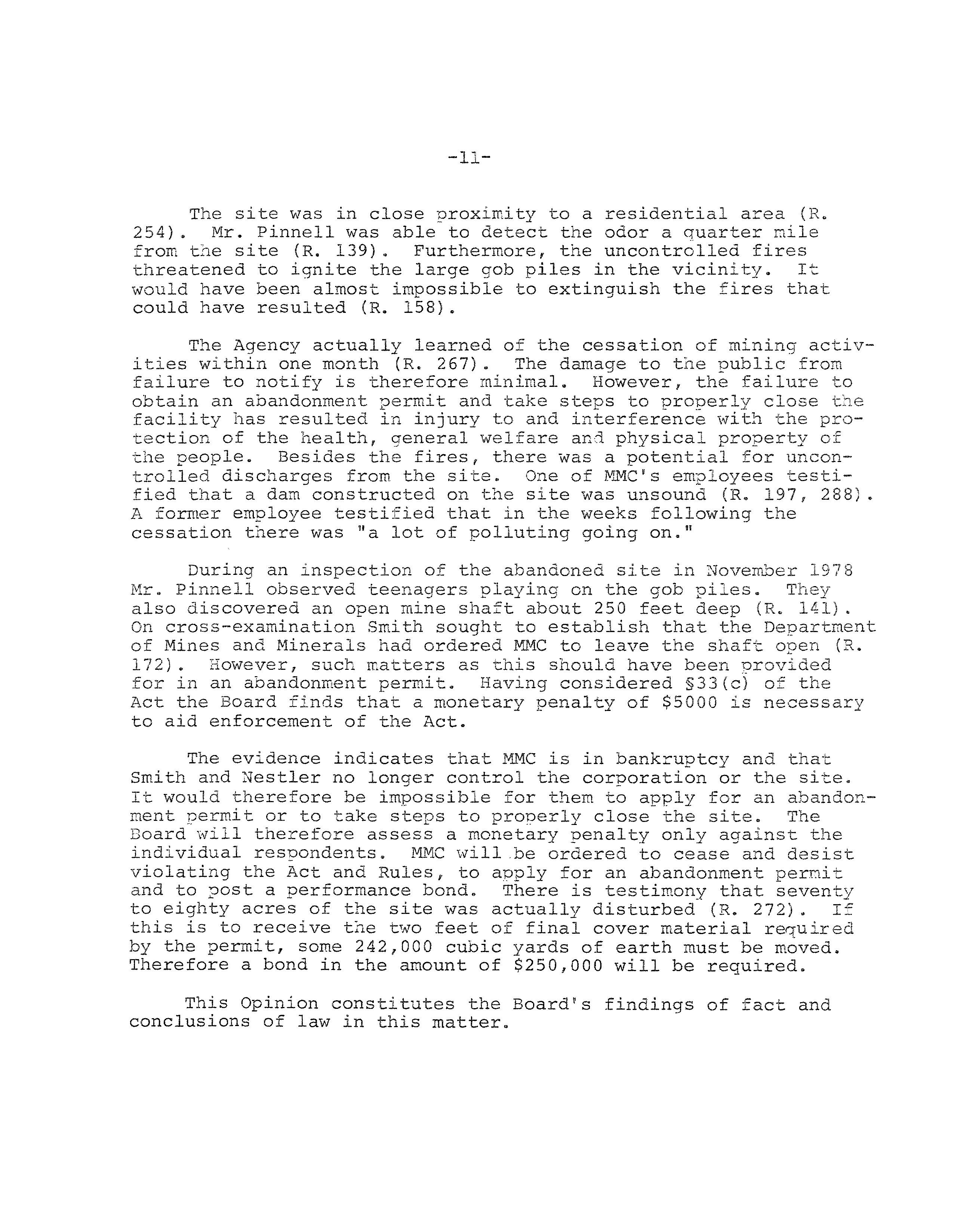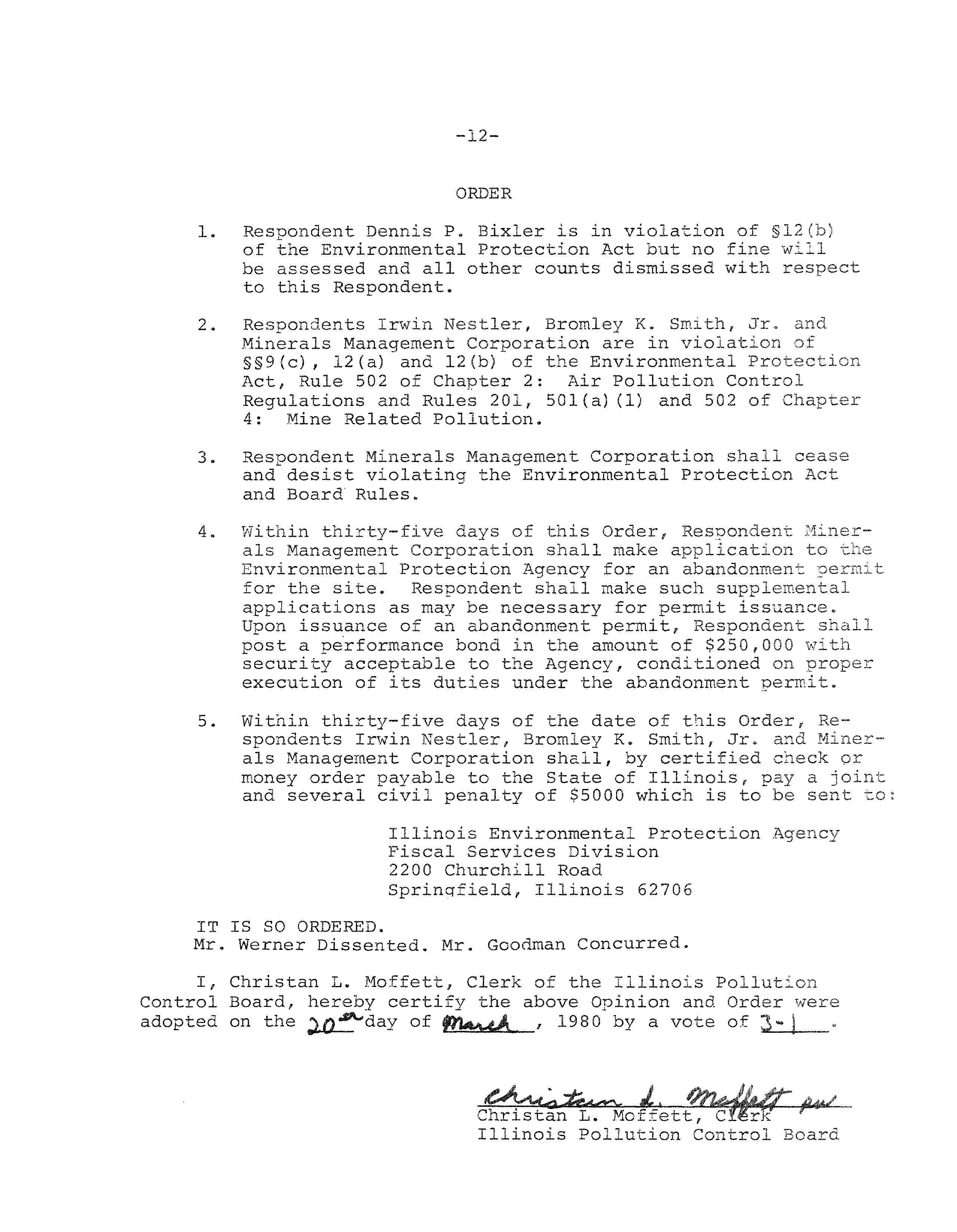ILLINOIS POLLUTION CONTROL BOARD
March 20,
1980
ENVIRONMENTAL
PROTECTION AGENCY,
Complainant,
)
PCB 79—58
MINERALS
MANAGEMENT
CORPORATION,
a
District
of
Columbia
conDoration;
IRWIN
NESTLER;
BROMLEY
K.
SMITH,
)
JR.;
JRMES
M.
DAY:
and DENNIS
P.
)
BIXLER,
Respondents.
MR.
STEPHEN
GROSSMARK,
ASSISTANT ATTORNEY
GENERAL,
APPEARED
ON
BEHALF
OF
THE
COMPLAINANT.
MR.
DENNIS
P.
BIXLER,
MR.
IRWIN
NESTLER
AND
MR.
BROMLEY K,
SMITH
APPEARED
PRO
SE,
OPINION
AND
ORDER
OF
THE
BOARD
(by Dr. Satchel?):
This
matter
comes before the Board uoon a complaint
filed
March
19,
1979 by the Environmental Protection ~.qency (Agency)
naming as Respondents Minerals Management Corporation
(MMC)
,
a
District
of Columbia Corporation, Irwin Nestler
(Nestler),
Broruley K.
Smith,
Jr.
(Smith), James
N. Day and Dennis P. Bixler
(Bixier).
On June 12,
1979 an amended complaint was filed,
The
Respondents operated a coal refuse processing and recovery
operation
on
the
abandoned
St.
Ellen mine site near O’Fallon,
St.
Clair
County.
The
complaint
alleges
violations
of
§~9(a),
9 (c)
,
12 (a) and
12 (b)
of
the
Environmental Protection Act
(Act)
Rule
502
of
Chapter
2:
Air
Pollution
Control
Regulations
and
Rules
201,
501(a)
(1)
and 502 of Chapter
4:
Mine :Related Pollution.
A
hearing
was
held in Belleville on October 29,
1979.
Members
of
the public attended but did not comment.
On December
3,
1979
the
Agency filed a motion for leave to amend complaint to conform to
the proof and second amended complaint.
Since there is no ob-
jection,
the motion is granted.
Complainant’s December
3,
1979
motion for leave to file its closing argument six days late
is
also granted.
—2—
On September 10 and 11 the Agency filed, pursuant to
Procedural Rule
701, motions
for sanctions against Respondents
MMC, Nestler
and Smith,
The motions allege that the Agency
served interrociatories on these Respondents
in June.
These were
not answered by the date specified.
On August
3 the Hearing
Officer ordered the Respondents
to answer by September
7,
1979,
Smith and Nestler contended that they responded to the inter-
rogatories by certified mail on June
28,
1979
(R.
11)
.
These
were received by the Board, but the Agency contends that it
received no copies until
a couple of weeks before the hearing
(R.
12),
Smith indicated he had receipts showing service, al-
though these were not introduced into evidence.
There was con-
fusion because of the withdrawal of Smith and Nestler’s attorney.
Since it appears that the Agency in fact received the papers well
in advance
of the hearing, the motion for sanctions is denied.
There is testimony that MMC was adjudicated bankrupt on
June
20, 1979
CR.
310,
317; Motion of July 18,
1979).
The bank-
ruptcy court was given notice of the hearing but the trustee or
receiver did not appear
(R.
9).
There is no suggestion in the
record that rroper service of process was not obtained on the
Secretary of State or registered agent of the corporation prior
to the bankrulDtcv,
However,
it
is suggested that the Board has
no jurisdiction over MMC
(R.
316).
The individual Respondents
have no authority
to sign pleadings for MMC or assert its rights
after the bankruptcy
CR.
9).
However, assuming a motion to dis-
miss MMC is before the Board,
it is denied.
The Board further
finds MMC in default pursuant to Procedural Rule 327.
On April
2 and 10, 1979 Smith, Nestler and James M.
Day
filed motions to dismiss,
Among other things these Respondents
objected to service of process upon them outside
of the State
of
Illinois.
The motions were denied by Order of the Board on April
26, 1979.
Parties objecting to personal jurisdiction must file a
special appearance pursuant to §20 of the Civil Practice Act
(Ill.
Rev.
Stat.
ch.
110,
§20).
Since the Respondents included with
their motions grounds
for dismissal other than lack of personal
jurisdiction, the motions were general appearances by which Re-
spondents voluntarily submitted to the Board’s
jurisdiction,
rendering the jurisdictional questions moot.
Respondent James
N.
Day was,
however, dismissed on the Agency’s motion in an Order
entered September 20,
1979.
—3—
The individual Respondents were officers or directors
of
MMC, which held the
permit
and
operated the site
(Comp,
Ex,
9).
The
complaint
alleges
that
the
individuals
violated
the
Act
through control of MMC’S actions.
The evidence
discloses that
they were actually on the site and in direct control of day to
day operations, which is ample to create liability
(R.
189,
200).
The
Aqency
suggests
that
this
result
is dictated by Section
3(i)
of the Act--the definition of “person.”
The argument
is
that
the
named Respondents were the “legal representatives
or agents”
of
MMC.
The Board rejects this argument.
The individuals
are
with-
out
a doubt “persons” within the meaning of the Act, regardless
of their relationship with MMC.
The Act proscribes various
act-
ivities of persons which cause pollution.
It makes no
difference
whether
the person utilizes an inanimate tool to cause pollution
or
instructs
his own employees or the employees
of a corporation
which
the
person controls.
EPA
v.
Collins Improvement Company,
mc,,
et
al.,
PCB 75—126,
19 PCB 221,
224
(1975).
The following is a summary of the allegations of the second
amended complaint:
Count
Act/Rule
Summary
§12 (b)
Construction
or
operation
of
a
facility
capable
of
causing
or
contributing
to
water
pollution
in
violation
of
permit
conditions,
J_ J_
III
IV
V
§12 (b)
Rule
201
of
Ch.
4
§12 (a)
Rule
501(a)
(1)
of
Ch.
4
§12 (a)
Rule 502 of Ch.
4
§~9(a) and
Cc)
Rule
502
of
Ch.
2
Conducting
mining
operations
outside
of
permitted
area.
Failure
to notify the
Agency
within thirty days of cessation
of mining.
Closing down a mine or mine refuse
operation which the operator does
not intend to reopen
without
a
permit
to
abandon.
Causing or allowing open burning
of mining materials and causing
or
tending to cause air
pollution.
Count
I
The
St.
Ellen
mine
site
is
an
abandoned
slope
mine.
MMC con-
ducted a coal refuse recovery operation on gob piles located
near
—4—
the
mine
entrance
(R.
47).
MMC
sought
to
recover
coal
left
from
earlier
operations
with
less
efficient
equipment.
Beginning
in
January,
1977
MMC
conducted
pre1imin~y
discussions
with
the
Anency
resulting
in
an
application
and
a
permit
issued
April
4,
1977
(H.
35,
45,
82,
110;
Comp.
Ex.
1).
A
supplemental
permit
was issued August 29,
1977
(R.
38,
45; Comp.
Ex.
2).
MNC proposed to dispose of the rejects remaining after the
recovery operation by supplying it
to the U.
S. Bureau of Mines
for use in backfilling nearby underground mines to prevent sub-
sidence.
Special Condition
#2 of the permit reads
as follows:
All rejects from the coal recovery operation are
to be removed from the mine site by the U.
S. Bureau
of Nines.
All refuse not removed from the site shall
be graded and covered with a minimum of two feet of
non—acid producing material and vegetation established
(Comp.
Ex.
1).
At the hearing the Agency introduced a notarized letter
from
the Bureau of Mines concerning its relationship with
MMC
(H,
287;
Comp.
Ex.
10).
Between December 17,
1976 and July 28,
1977 the
Bureau discussed the project with
NMC
but had had no further con-
tact after that date,
MMC
represented
in Schedule MC of
the per-
mit application that details of removal of refuse by
the
Bureau
of
Mines “should be completed by March 15,
1977”
(Comp.
Ex.
1).
The
Bureau of Mines never entered into an agreement with
MMC
on
re—
inoval of refuse from the site.
Letters from
the
Bureau
to
MMC
were introduced but not admitted into
evidence
CR.
294,
300,
312;
Smith’s
Ex.
2,
3).
On
July
31,
1978
MMC
in
a
letter
to
the
Agency
requested modification of its permit to remove the reference to
the Bureau of Mines
(H.
307; Smith’s Ex.
1).
Apparently an ap-
plication followed on August
9,
1978.
The Agency responded with
a request for information on October 6,
1978 and
a denial on
October
26,
1978
(H.
325;
Comp.
Ex.
14,
15).
On cross—examination of the Agency’s witnesses Respondents
sought
to
establish
that
special
condition
#2
contained
alternative
provisions
for rejects——they could be removed by the Bureau
of
Mines
or
graded
and
covered
at
MM.C’s
election
(H.
59,
62,
97).
However,
a
reading
of
the
application,
especially
Attachment
B,
indicates that ~4C represented to the Agency that the refuse piles
—5—
would
be
removed
by
the Bureau of Mines
(R.
122,
127;
Comp.
Ex,
1).
The condition was based on this understanding and the provision
for grading and covering that which was not so removed was not
intended to allow
an alternative mode of routine operation.
Re-
spondents waited a full year after their last contact with the
Bureau of Mines before applying for a supplemental permit, even
though they were informed
that
the subsidence project was
termin—
ated
CR.
116,
304).
Respondents
further
attempted
to
establish
that
the
permit
contained
no
time
schedule
for
removing
or
covering
the
rejects
(H.
57).
A
reading
of
the
entire
permit
indicates
that
this
was
to
be
continuous
over
the
life
of
the
permit.
However,
even
if
Respondents’
argument
is
accepted,
the
permit
expired
April
4,
1979
with
the
rejects
not
covered
or
graded
(Cornp.
Ex.
I).
Smith
testified
that
“at
the
time
of
issuance
of
the
permit
and
throughout
the entire operational history of
the
site,
all
first wash rejects were planned to be recycled,”
(H.
290).
Material
was
to
be
stored
to
he
processed
a
second
time,
apparent-
ly
after
more
efficient
processing
etjuipment
was
installed
(H,
61,
97,
117,
226,
234).
Smith~sstatement~of intent was accepted by
the Hearing Officer for the limited purpose of §33(c)
(H.
292),
If
MMC either intended to run the rejects again through the exist-
ing plant
or one to be constructed, this
is not the procedure
contemplated in
the
application and permit.
Special Condition #1 provided that there should be no dis-
charge of process water from the facility.
Water from the pro-
cessing plant was
to be discharged into a series of settling ponds
from which make up water was to be pumped back to the processing
plant
(Comp.
Ex,
1).
Testimony was given concerning
a discharge
which occurred on September 7,
1977
CR.
88,
242; Comp.
Ex.
11),
A further discharge occurred in April,
1978
(H.
89,
108,
125),
Apparently one of these resulted from actions of
H.
N. Harmon Bus
Company on land adjacent
to
MMC’S
site.
Any process water dis-
charge from
NMC
would be
a breach of permit condition regardless
of any contaminants in the water.
Bixler was president of
MMC
and signed the permit applications
(Comp.
Ex.
1),
He lived in the Belleville area; whereas, Nestler
and Smith commuted from Washington, D.C.
(H.
200),
During the
early phases of the operation he was manager of the site
(H.
189,
211,
249).
In November,
1977 Bixier was relieved of his position
as manager and barred from the site
(H.
319; Bixler Ex,
2).
On
November 23,
1977 he was removed from his position as president
and a director of
MMC
(Bixler’s Ex.
1,
3).
—6—
Bixler
was
directly
responsible
for
the
violations
of
Special
Condition
#2 from April through October
1977.
The Board therefore
finds
him
in
violation
of
§12(b)
of
the
Act
for
this period.
How-
ever,
the record is unclear as to exactly when the Bureau of Mines
definitely indicated that they would not accept the refuse.
It is
possible that the operations during this period may have been under-
taken in good faith on the assumption that the Bureau of Mines
would eventually take the refuse which was accumulating.
There is
testimony by a former Agency employee that MMC
made prompt efforts
to correct deficiencies during Bixler’s tenure
(R.
94,
106).
in
January 1979 he assisted the Agency in putting out fires on
the
site
(H.
151,
161).
Therefore the Board will assess no penalty
against Bixler.
Since the remaining counts involve events subse-
quent to November, 1977 they will be dismissed with regard to
Bixler.
Count
II
Count
II
alleges violation of §12(b)
of the Act and
Rule 201
of Chapter 4 by conducting mine operations outside the
permitted
area.
Rule 201 requires a permit for mining operations.
The
charge
is that by mining adjacent to, but outside of the permitted
area,
the Respondents were mining without
a permit.
It
should
be
noted that under the proposed revisions to Chapter
4 mining activ-
ities outside the permit area but adjacent to it will ordinarily
be on the same facility.
If a permit is held for the facility,
mining outside the permit area will be a breach of condition but
will
not amount to mining without
a permit
(See R77-lO, Proposed
Order, December
13,
1979).
However, under the existing Chapter
4
the allegation
is sufficient to constitute violation of Rule 201.
The permit specifies that it “specifically covers only the area
designated as Phase
I on the map included in
the
application”
CR.
53,
58,
63; Comp.
Ex.
1).
The map attached to Complainant’s
Exhib-
it
1 consists of a group
of
photocopies taped together.
Apparently
the top of the map faces west,
Phase
I is indicated by a dark,
solid line and includes the north gob pile.
Phase
2
is indicated
by a dotted line and includes the west and most of the east gob
piles.
Phase
1 of the operation was
to utilize
an existing Stand—
ley
Coal
Washing
Plant
located
between
the
east
and
north
gob
piles
in
the
south
half
of
the
Phase
1 area (Attachment A, Comp.
Ex.
1).
An
Agency
inspector
testified
that
on
Nay
5,
1978
mining
operations
were
going
on
outside
of
Phase
I.
Operations
were
in-
side
Phase
2
and
also
outside
of
both
Phase
1
and
Phase
2
CR.
256,
273),
An
inspection
of
Nay
25,
1978
disclosed
similar
operations
CR.
258,
280,
283),
There
is
no
indication
of
operations
outside
—7--
of
Phase
I
in inspections made
on
July
Il
and
August 22,
1978
(H.
260).
The
Agency
conducted
aerial
surveillance
on
August
28,
1978
(H.
262;
Comp.
Ex.
13)
There is testimony that operations
were
being
conducted
to
the
southwest of the old washer plant.
This would be near the boundary between Phase
1 and Phase
2,
How-
ever, there is no indication of which phase operations were
in
(H.
266)
.
On cross—examination
an Agency witness marked locations on
a map identified
as Smith’s Exhibit
1.
This map was not offered
or
received
into
evidence
and
is
not
included
with
the
exhibits
forwarded
by
the
Hearing
Officer
CR.
274,
283).
The
evidence
therefore
establishes
operations
outside
of
the
Phase
I
during
May,
1978.
On
May
25,
1978
the
Agency
held
a
meeting
with
Smith
to
discuss
this
(H.
258)
Smith
testified
that
at
all
times
the
processing
and
equipment
utilized
on
the
site
were within Phase
1
under
the
permit
except
for
a
slurry operation
for materia:L
removed from the northwest
corner
of the site,
He
testified that operations “were ceased”
in that area and a “supple-
mental
permit
was
filed
with
the Illinois Environmental Protection
Agency”
CR.
306).
Smith
introduced
a
letter
to
the
Agency,
dated
July
31,
1978 which requested a sup~~plementalpermit to cover areas
“inadvertently left off the
basic
site
plan
as
filed”
CR.
307;
Smith’s
Ex.
4).
On rebuttal an Agency inspector testified that
the
slurry
circuit
of
the
second
processing
plant
was outside Phase
1 and virtually to the extreme of the Phase
2 area
(H.
327).
The
Board therefore
finds that operations occurred outside Phase
I in
violation of §12(b)
of the Act and Rule 201 of Chapter
4
during
the
period from May
5 through July 31,
1978.
Count III
Count III
alleges
violations
of
§12(a)
of
the Act and Rule
501(a) (1)
of Chapter
4, which reads as
follows:
Within thirty days of the cessation of mining or all
mine
refuse
disposal
operations,
unless
caused
by
a
labor
dispute
or
mechanical
failure,
the
operator
shall
notify
the
Agency.
In
September,
1978
Smith
and
Nestler
held
a
meeting with a
creditor bank in St.
Louis.
After that meeting,
on September 25,
1978 the sheriff pulled most of the equipment off the site
(H.
202,
232),
The last pay
day
was
September 5,
1978 and the work force
was laid off on September 26, 1978
(H.
203).
Some employees re-
mained until early or mid-October to guard the site,
There
has been
no further mining activity since September 25,
1978
CR.
208).
At
that time the plant was operable, although the remaining equipment
in
the
condition
it
was
in
was
not
sufficient
to
feed
refuse
into
the plant
(H.
233,
238),
The Agency has received no notification
of cessation of operations
CR.
270).
The Board therefore finds
that
Nestler,
Smith
and
MMC
failed
to
notify
the
Agency
of
cessa-
tion
of
operations
substantially
as
alleged
in
Count
III.
Count
IV
Count IV charges that Respondents
violated
§12(a)
of the Act
by
abandoning the site
without obtaining an abandonment permit as
required by Rule 502 of Chapter
4,
which reads
as follows:
if
an
operator
closes
down
a
mine
or
mine
refuse operation and
.
.
an
operator
does
not
intend
to
reopen
the
operation,
the
operator
shall,
within
one
year of the date of close-down,
obtain a permit to
abandon.
Rule
103(a)
defines
“abandon”
as
follows:
“Abandon”
is
to
close
down
a
mine
or
mine
refuse
area
with
no
intention
to
reopen
said area;
.
.
.
A
mine
or
mine refuse area which has been inoperative for one year
shall
be
rebuttably
presumed
to
be
abandoned.
There
was
a
cessation
of
operations
on
September
25,
1978.
On October
18,
1978 an Agency inspection found no personnel on
the site.
The power had been disconnected and a hole cut in the
wall
of
the
office
trailer
to
remove
an
air
conditioner
(H,
268).
An inspection of December 21,
1978
revealed
smoldering
fires
(H.
184),
On January 24,
1979 there were three active fires
in piles
on the
site
(B,
139).
Mr.
Thomas Pinnell,
Chief Inspector for the
Department of Mines and
Minerals,
sorted
through
debris on the
floor
of
the
vandalized
office
trailer
to
find
a purchase order with MMC’S
Washington,
D.C.
address
and
phone
number
(H.
144).
The
phone
number
had
been
disconnected.
Nestler
and
Smith
were
eventually
contacted
after
federal
agencies
referred
the
State
to
Bixler
(H.
147)
Although
the
processing
plant
was
operational
after
cessation,
the
equipment
on
the
site
was
inadequate
in
the
condition
it
was
in
to feed refuse to the plant
CR.
233,
238).
Sometime prior to
that
date
the
city
had
shut
off
water
service
for
failure
to
pay
the
b~1l.
Input
of
fresh
water
into
the
system
was
necessary
for
operation
of
the
old
plant
CR.
196).
MMC had not
paid
its employees
for
two
weeks
and
owed
other
creditors
CR.
202,
207).
—9—
At the time of the hearing the site had been inoperative for
more than one year.
It is
therefore presumed abandoned,
Smith’s
testimony that he conducted negotiations to recapitalize MMC from
October, 1978 through April,
1979
is not sufficient to persuade
the Board that the operation was not
in fact abandoned on
September
25,
1978
CR.
310).
Respondents’
objection that the first amended
complaint was
filed less than one year after the abandonment is
rejected
CR.
311),
This
is
irrelevant since the hearing occurred
more than one year after the close—down.
Since no permit to
abandon has been obtained, the Board
finds Nestler,
Smith and MMC
in violation of §12(a)
of the Act and Rule 502 of Chapter 4 sub-
stantially
as alleged in Count IV,
Count
V
Count V alleges violation of
§9(a)
of the Act, which proscribes
emission of contaminants into the atmosphere so as to cause
or tend
to cause air pollution or to violate standards adopted by the Board.
The evidence is insufficient to find
a violation of §9(a).
Count V
also alleges violation of §9(c)
and Rule 502 of Chapter
2:
Air
Pollution Control Regulations by causing or allowing open burning.
On December 21,
1978
an Agency inspector found
a small pile
of reclaimed coal smoldering on the site
(R.
185).
On January 24,
1979 Mr.
Pinnell found three spontaneous combustion
fires burning
on the site
CL
139).
Two fires were in processed coal piles con-
taining sixty and seventy-five tons of coal.
The third was
a pile
of fines which was 60—70
coal
CR.
140),
When Nestler was con-
tacted he said he wouldn’t do anything because they didn’t have
any money
(H.
151).
The fires were extinguished under Department
of Mines and Minerals supervision by
a local contractor at a cost
of $3500 which was provided by the federal government
CR.
152),
Mr.
Pinneil,
as an expert witness, testified that it was
necessary to take certain measures to prevent coal piles from
spontaneously igniting when exposed to air and water,
New coal
mines protect processed coal
from the elements by storage in a
silo.
Where
this
is not available
it is
necessary
to continuously
move and compact coal piles
CR.
134,
159,
169),
The Board finds
that Nestler, Smith and MMC caused or allowed open burning through
their actions
in creating coal piles which were susceptible to
spontaneous combustion, through their failure to take steps
to
prevent spontaneous combustion and through their failure
to take
steps
to
extinguish
the
fires.
These
Respondents
are
in
violation
of
§9(c)
and
Rule
502
of
Chapter
2
substantially
as
alleged
in the
complaint.
l0
The comolaint alleqes that combustion of mine refuse
occurred
“during
a
period
beginning
on
or
about
December
15,
1978
and ending on or
about
January
6,
l978~’* Respondents objected to
the testimony concerning January 24,
1979
since fires occurring
on this date were not alleged in the complaint.
The Hearing Of-
ficer deferred to the Board ruling on the relevancy of this test-
imony
(B.
168).
The Agency did not attempt to remedy this with
its amendment to conform to proof.
The Agency offered testimony that there was fire on the site
on December 21,
1978 within the time period alleged
(R.
185)
The fires were
a consequence of
Resnondents’
acts and omissions.
In paragraph 15 of Count V the ?\gency alleged that there have been
no measures taken to prevent air pollution “since on or about
October
1,
1978.”
This allegation was sufficient to inform Re-
spondents of a continuing violation up to the date of the complaint.
The testimony concerning the fires of January
24,
1979 will he con-
sidered only as affectinq the oenaltv under §33 Cc)
of the Act and
as cumulative evidence that Respondents’
acts and omissions
could
result in open burning.
Section
33(c)
and Penalty
A former Agency inspector testified that the entire St. Ellen
site was
a serious environmental problem
(B.
85)
.
However, most
of this problem was present before Respondents came onto the site.
The
recovery operation sought to reclaim valuable but discarded
coal.
had
the
operation
proceeded
as
olanned,
it
would
have
eliim-
mated a large potential source of oollution, provided material to
the
subsidence program
and
reclaimed
the
land
for other productive
uses.
Hc~wever, Respondents could
have
taken
technically practic-
able and economically reasonable measures to minimize the dis—
charges and emissions during and after their operation.
Smith
contended
he
had no money with which to fight the spon-
taneous combustion fires
(B.
151).
However,
two of the piles
were
processed coal and one was 60—70
coal
fines
CR.
140)
.
Since this
was the end product of Respondents’
operations
it seems likely
that it could have been sold or at least given away in exchange for
haulaqe.
In his brief Smith contends
that the coal was not actually
salable
(Smith’s Brief,
8).
The Board will disregard this and all
other factual assertions
in the brief which are not supported by
the record.
*The Respondents have conceded that this
is
a tvpoaranhical error
which should read “January 6,
1979”
(H.
164)
—11-
The
site
was
in
close
proximity
to a residential area
(H.
254).
Mr. Pinnell was able to detect the odor a quarter mile
from the site
(H.
139),
Furthermore, the uncontrolled
-fires
threatened to ignite the large gob piles in the vicinity.
It
would have been almost impossible to extinguish the fires that
could have resulted
CR.
158).
The Agency actually learned of the cessation of mining activ-
ities within one month
(B.
267).
The damage to the public from
failure to notify
is therefore minimal,
However, the failure
to
obtain an abandonment permit and take steps
to properly close the
facility has resulted in injury to and interference with the pro-
tection of the health,
general welfare and physical property of
the people.
Besides the fires, there was a potential for uncon-
trolled discharges
from the site.
One of MMC’s employees testi-
fied that a dam constructed on the site was unsound
(B,
197, 288).
A former employee testified that in the weeks following the
cessation there was
“a lot of polluting going on.”
During an inspection of the abandoned site
in November 1978
Mr. Pinnell observed teenagers playing on the gob piles.
They
also discovered an open mine shaft about 250 feet deep
(H.
141),
On cross-examination Smith sought to establish that the Department
of
Mines
and
Minerals
had
ordered
MMC to leave the shaft open
CR.
172)
.
However,
such
matters
as
this
should
have
been
provided
for
in
an
abandonment
permit.
Having
considered
§33(c)
of the
Act
the
Board
finds
that
a
monetary
penalty
of
$5000
is
necessary
to
aid
enforcement
of
the
Act.
The
evidence
indicates
that
MMC
is
in
bankruptcy
and
that
Smith and Nestler no longer control the corporation or the site,
It
would
therefore
be
impossible
for
them
to
apply
for
an
abandon-
ment
permit
or
to
take
steps
to
properly
close
the
site.
The
Board will therefore assess
a monetary penalty only against the
individual resoondents,
MMC will be ordered to cease and desist
violating the Act and Rules,
to apply for an abandonment permit
and
to
post
a
performance
bond,
There
is
testimony
that
seventy
to
eighty
acres
of the
site
was actually disturbed
(H.
272)
If
this is
to receive the two feet of
final
cover material required
by the permit,
some 242,000
cubic yards of earth must be moved.
Therefore a bond in the amount of $250,000 will be required.
This
Opinion
constitutes
the
Board’s
findings
of
fact
and
conclusions of law in
this
matter.
ORDER
1.
Respondent Dennis
P.
Bixler is in violation of §12(b)
of
the
Environmental
Protection
Act
but
no
fine
will
be assessed and all other counts dismissed with respect
to this Respondent.
2.
Respondents
Irwin Nestler,
Broinley K.
Smith,
Jr.
and
Minerals Management Corporation are
in violation
of
§~9(c),12(a)
and 12(b)
of
the Environmental Protection
Act, Rule 502 of Chapter
2:
Air Pollution Control
Regulations and Rules
201,
501(a) (1)
and 502
of Chapter
4:
Mine
Related
Pollution.
3,
Respondent
Minerals Management Corporation shall cease
and desist violating the Environmental Protection Act
and Board Rules.
4,
Within thirty-five days of this Order, Respondent Miner-
als Management Corporation shall make application to the
Environmental Protection Agency for an abandonment oemmit
for
the
site.
Respondent
shall
make
such
supplemental
applications
as may be necessary for permit issuance,
Upon issuance of an abandonment permit, Respondent shall
post a performance bond in the amount of $250,000 with
security acceptable
to the Agency,
conditioned on proper
execution of its duties under the abandonment permit.
5.
Within thirty—five days of the date of this Order, Re-
spondents Irwin Nestler, Bromley K.
Smith,
Jr.
and Miner-
als Management Corporation shall, by certified check ~r
money order payable to the State
of Illinois,
pay a joint
and several civil penalty of $5000 which
is to be sent to:
Illinois Environmental Protection Agency
Fiscal Services Division
2200 Churchill Road
Springfield, Illinois
62706
IT IS SO ORDERED.
Mr. Werner Dissented.
Mr. Goodman Concurred.
I, Christan L. Moffett, Clerk of the Illinois Pollution
Control Board,
hereby certify the above Opinion and Order were
adopted on the
~p~day
of
~
,
1980 by
a vote of
~stanL.Moffett,cr~
Illinois Pollution Control Board
